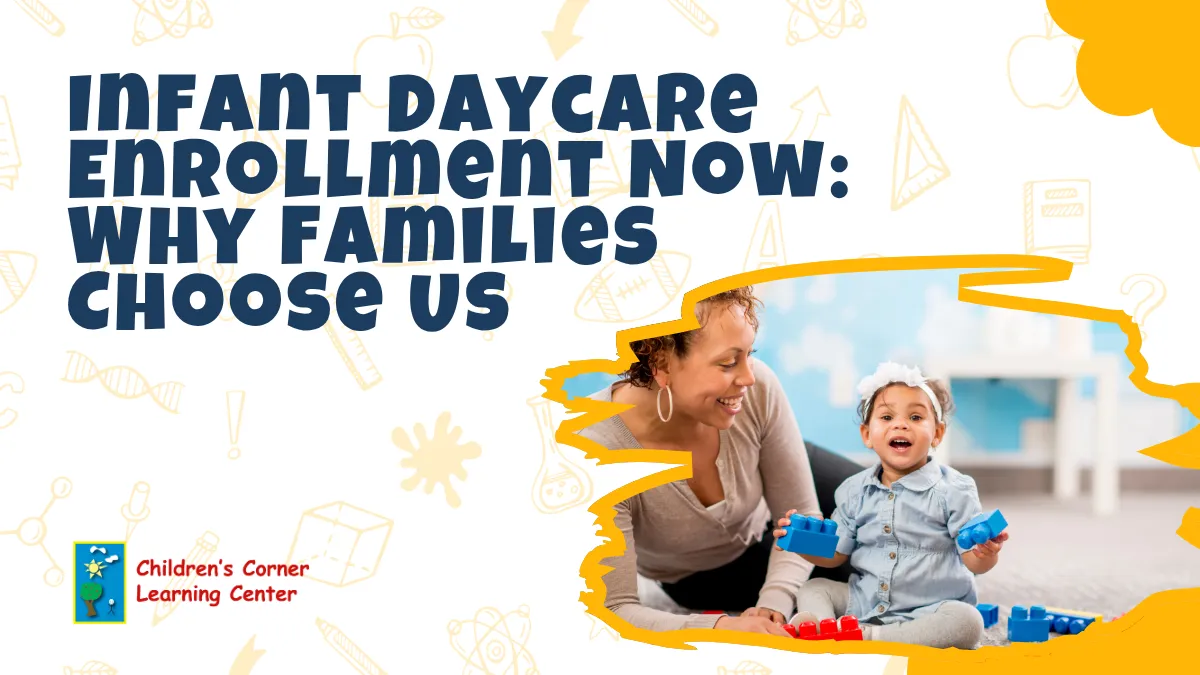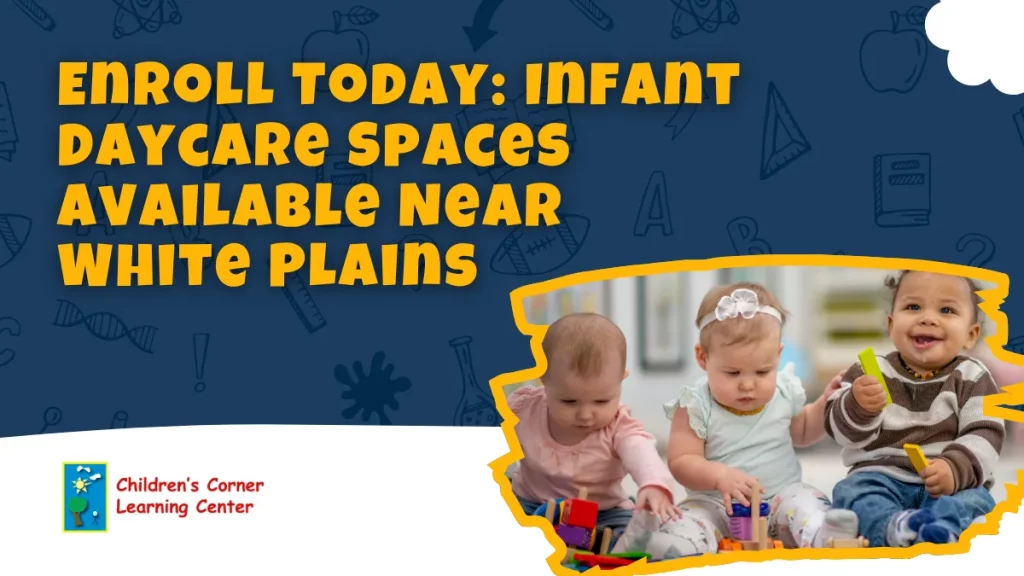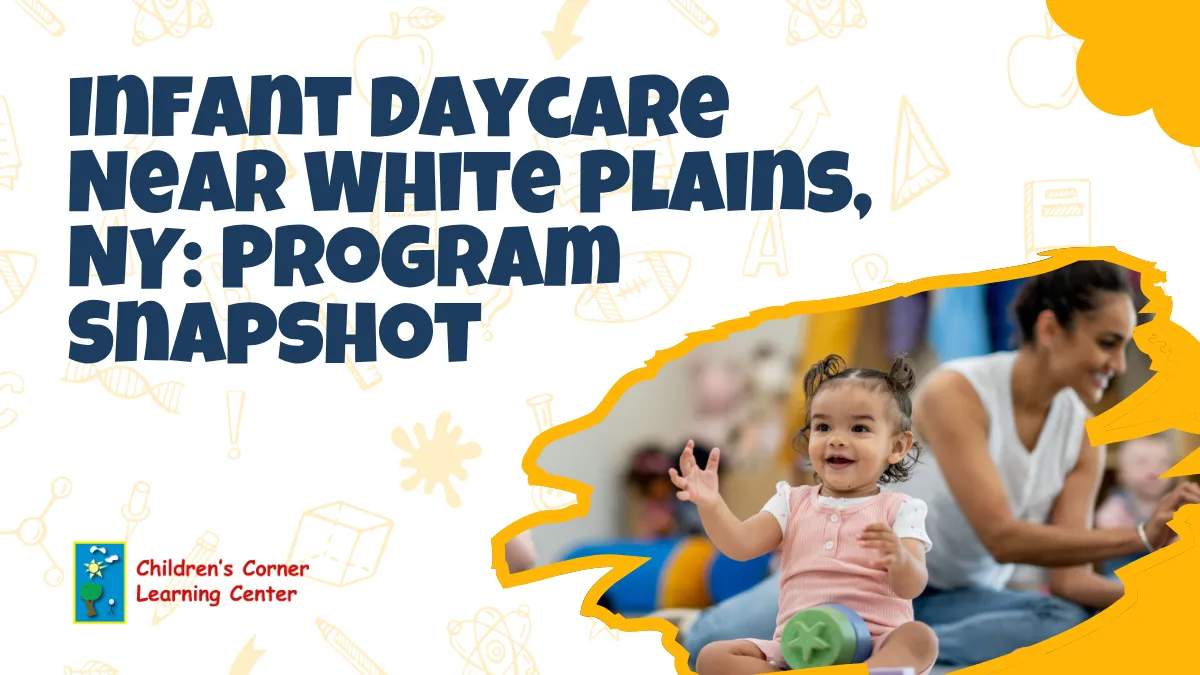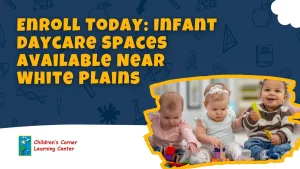Infant daycare spaces open near White Plains offer families timely access to nurturing care and developmentally appropriate routines. Our infant program supports healthy growth through responsive caregiving, individualized schedules, and safe, well-equipped classrooms designed for early exploration. Daily communication, secure check-in procedures, and strict health and cleanliness standards reassure parents who need reliable care.
Experienced educators engage babies with gentle sensory activities, tummy time, music, and language exposure that build early milestones. If you seek quality care near home, these limited openings ensure your child benefits from a warm environment that prioritizes safety, consistency, and strong foundations for future learning.
Infant Daycare Enrollment Now: Why Families Choose Us

Families choose our program for a careful balance of nurturing care, safety, and professional standards. Classrooms are arranged for calm exploration, transitions are supported with predictable routines, and every decision centers on secure attachments, healthy development, and transparent communication with parents.
Experienced Educators And Low Ratios
Infants thrive with attentive, responsive care. Our trained teachers read cues, follow individual schedules, and provide consistent comfort. Low ratios support one-on-one interactions that build trust and reduce overstimulation. Daily experiences include gentle language modeling, music, and sensory play that encourage curiosity while respecting each child’s natural rhythm and needs.
Safety, Health, And Cleanliness Standards
Safety is practiced in every routine. Secure entry and check-in procedures protect arrivals and departures. Handwashing, bottle handling, and crib protocols follow current guidance. Toys and surfaces are cleaned throughout the day, with scheduled sanitizing after hours. Wellness checks help maintain healthy classrooms, and clear exclusion policies minimize the spread of illness.
Developmental Care Plan For Every Infant
Learning begins with responsive caregiving. Teachers plan age-appropriate activities that strengthen motor skills, early communication, and social development. Tummy time, grasping practice, object permanence games, and simple stories are introduced gradually. Progress is documented through observation notes and photos, giving parents a clear view of milestones and next steps.
Daily Communication And Family Partnerships
Parents receive updates on bottles, naps, diapers, and classroom highlights. Teachers invite input on comfort items, sleep preferences, and feeding details to align school and home routines. Conferences and ongoing check-ins review growth and goals, ensuring care plans reflect each child’s temperament, interests, and developmental stage.
Enrollment Availability And Next Steps
Families can secure a dependable placement without delay with infant daycare enrollment now prioritized. Limited class sizes preserve individualized attention and continuity of care. If you are seeking infant daycare near White Plains, NY, and need infant daycare spaces open, our team is ready to support a smooth start and a confident transition.
Infant Daycare Near White Plains, NY: Program Snapshot

Families seeking infant daycare near White Plains, NY, will find a calm, organized environment that prioritizes safety, responsive caregiving, and early developmental growth. Classrooms support secure attachments and predictable routines so infants feel comfortable and engaged from the first day.
Ages Served, Ratios, And Staffing
The program welcomes infants beginning at six weeks. Low teacher-to-child ratios allow attentive supervision and timely responses to individual cues. Educators are trained in infant development, safe sleep practices, health procedures, and ongoing observation, sustaining consistent, high-quality care throughout the day and transitions.
Daily Routines And Classroom Flow
Infants follow individualized bottles, naps, and diapering schedules while experiencing gentle, age-appropriate activities. The classroom layout includes soft floor zones for exploration, cozy reading spaces, and safe areas for early mobility. Transitions are paced to reduce overstimulation, preserve a calm atmosphere, and maintain consistent comfort.
Learning And Developmental Experiences
- Tummy time for early core strength and head control
- Grasping, reaching, and cause-and-effect play to build fine-motor skills
- Music, simple stories, and face-to-face engagement to support early language
- Object permanence games and textured materials to encourage curiosity
Health, Safety, And Cleanliness
Secure entry procedures, accurate attendance, and vigilant supervision anchor daily safety. Handwashing routines, bottle handling protocols, and crib checks follow current guidance. Toys and surfaces are cleaned daily, with scheduled sanitizing after hours. Wellness screening and clear exclusion policies help maintain a healthy classroom community.
What To Bring, What’s Included, And Enrollment
Families receive a concise supply list during enrollment to ensure a smooth start. Program tuition includes daily learning materials, developmental observations, and consistent family communication. Limited openings preserve small group sizes and continuity of care; current availability, tour scheduling, and required documents are reviewed during enrollment to support confident placement and a comfortable transition.
Immediate Infant Day Care Openings: Availability And Start Dates
Families seeking placement can take advantage of immediate infant day care openings designed to preserve small group sizes, individualized routines, and continuity of care. Availability is updated in real time and prioritized for infants who will benefit from a calm, predictable transition into the classroom.
Current Availability And Class Size
Openings are limited to maintain low ratios and steady attention to feeding, sleep, and comfort needs. Each classroom balances new enrollments with experienced peers so infants encounter familiar routines, consistent caregivers, and a soothing environment that promotes secure attachments from the first week.
Start Dates And Transition Plan
Start dates are scheduled to protect classroom flow and to give families a clear runway. A gradual transition is recommended, beginning with a brief visit, a half-day, and then a full schedule. This approach allows caregivers to learn cues, align bottle and nap timing, and tailor comfort strategies before a full start.
Enrollment Steps And Required Documents
- Apply and confirm an available start date
- Provide immunization record and recent health form
- Share feeding details, sleep preferences, and comfort items
- Review safe sleep, illness, and communication policies
- Complete emergency contacts and authorized pickup list
Tuition, Inclusions, And Placement Holds
Tuition reflects low ratios, trained infant educators, and daily communication. Services typically cover developmental observations, learning materials, and secure check-in procedures. If a later start is needed, short placement holds may be available for a defined period; details are reviewed during the enrollment conversation to ensure clarity on timelines and fees.
Family Communication Before Day One
Families receive a supply list, first-week schedule, and caregiver introductions before the start date. A brief questionnaire documents bottle preparation, nap routines, and soothing methods so home practices carry into the classroom. During the first days, naps, bottles, diapers, and comfort updates are shared, with adjustments made as infants settle into the new routine.
Timely access to immediate infant day care openings supports a confident start while preserving the calm, attentive care infants need. This availability framework aligns start dates, staffing, and family preferences to create a dependable, developmentally sensitive beginning.
Daily Communication, Care Routines, And Nutrition
Families receive timely information, and infants benefit from steady, individualized care. Each routine supports comfort, healthy development, and a smooth partnership between home and school.
Family Updates And Transparency
Daily updates summarize naps, bottles, diapers, and classroom highlights so parents can track patterns and progress. Notes include observations on cues, mood, and new skills, with photos shared when appropriate. Teachers respond to questions promptly and invite preferences that help align home routines with the school day.
Typical update details include:
- Bottle volumes and times
- Nap start and end times
- Diaper frequency and notes
- Activity highlights and milestones
Individualized Care Routines
Care plans reflect each infant’s schedule and temperament. Teachers follow parent guidance on bottle preparation, pacing, and soothing methods while observing cues to adjust as needs change. Transitions between activities are calm and predictable, supporting regulation and secure attachments. Comfort items are welcomed when labeled and developmentally appropriate.
Safe Sleep And Health Monitoring
Safe sleep practices guide every nap. Cribs are labeled, sheets are fitted, and sleep checks are documented. Infants are placed on their backs, with sleep surfaces kept free of loose items. Wellness screening occurs daily, and clear exclusion and return-to-care policies help maintain a healthy classroom environment.
Nutrition And Feeding Practices
Feeding is unhurried and responsive. Families may provide breast milk or formula with clear labeling and storage instructions. Teachers follow hygienic bottle handling, warming, and sanitizing procedures and monitor intake to support growth.
Nutrition supports include:
- Adherence to parent-provided feeding plans
- Tracking of ounces consumed and feeding intervals
- Introduction of solids per family guidance and developmental readiness
- Communication about appetite changes or sensitivities
Collaboration And Next Steps
Ongoing check-ins and periodic conferences review progress, goals, and any adjustments to care plans. If patterns suggest schedule changes—such as longer wake windows or evolving feeding intervals—teachers collaborate with families to implement updates gradually. This consistent communication ensures that daily care routines and nutrition practices remain aligned, supporting comfort, development, and continuity between home and the classroom.
Conclusion
A strong start in the first year depends on steady routines, skilled caregivers, and a calm environment that supports early milestones. This program pairs low ratios with responsive care, secure arrivals, and research-informed experiences so infants build trust and confidence from day one. Families see clear evidence of progress through daily communication, observation notes, and thoughtful transitions that honor each child’s rhythm.
Immediate openings and structured start dates allow timely enrollment while preserving small class sizes and continuity of care. Safety and cleanliness are anchored in consistent procedures, and nutrition practices follow family guidance to maintain comfort and growth. These elements create a dependable foundation for healthy development and a smooth partnership between home and school.
Ready to explore next steps? Book a tour or call to discuss availability: (845) 250-5492, https://www.childrenscornergroup.com/book-a-tour/.










